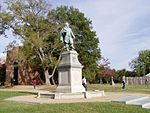Portal:Virginia
The Virginia Portal  Virginia, officially the Commonwealth of Virginia, is a state in the Southeastern and Mid-Atlantic regions of the United States between the Atlantic Coast and the Appalachian Mountains. The state's capital is Richmond and its most populous city is Virginia Beach, though its most populous subdivision is Fairfax County, part of Northern Virginia, where slightly over a third of Virginia's population of 8.72 million live. The Blue Ridge Mountains cross the western and southwestern parts of the state. The state's central region lies predominantly in the Piedmont. Eastern Virginia is part of the Atlantic Plain, and the Middle Peninsula forms the mouth of the Chesapeake Bay. The fertile Shenandoah Valley fosters the state's most productive agricultural counties, while the economy in Northern Virginia is driven by technology companies and U.S. federal government agencies, including the U.S. Department of Defense and Central Intelligence Agency. Hampton Roads is also the site of the region's main seaport and Naval Station Norfolk, the world's largest naval base. (Full article...) Selected article
The Battle of Blandford (or Blanford), also called the Battle of Petersburg, took place near Petersburg, Virginia on 25 April 1781, late in the American War of Independence. Roughly 2,300 British regulars under the command of Brigadier General William Phillips defeated about 1,000 militia under Major General Baron von Steuben.
The introduction of a British troop presence led by turncoat general Benedict Arnold into Virginia in early 1781 prompted an increase in militia activity to counter the British force. The militia were, however, poorly trained and equipped, and were unable to prevent Arnold from moving freely. Arnold was reinforced in March 1781 by additional troops led by General Phillips, who targeted Petersburg in a raiding expedition. Militia forces led by von Steuben and Peter Muhlenberg decided to make a stand at Blandford, then a separate community. When the battle was joined, the outnumbered militia provided remarkably stiff resistance to the British advance, and executed a disciplined retreat across the Appomattox River, avoiding a flanking attempt led by John Graves Simcoe. They eventually retreated to Richmond, where they joined forces with Continental Army troops led by the Marquis de Lafayette. The British continued raiding, and eventually joined forces with Charles Cornwallis's army from North Carolina. Selected biography
Zachary Taylor (November 24, 1784 – July 9, 1850) was the 12th President of the United States (1849–1850) and an American military leader. His 40-year military career ended with far-reaching victories in the Mexican–American War. His status as a national hero won him election to the White House despite his vague political beliefs. His top priority as president was preserving the Union, but he died 16 months into his term, before making any progress on the status of slavery, which had been inflaming tensions in Congress.
Taylor was born to a prominent family of planters who migrated westward from Virginia to Kentucky in his youth. He was commissioned as a U.S. Army officer in 1808. His success in the Second Seminole War attracted national attention and earned him the nickname "Old Rough and Ready". The Mexican–American War broke out in May 1846, and Taylor led American troops to victory in a series of battles culminating in the Battle of Palo Alto and the Battle of Monterrey. He became a national hero, and political clubs sprung up to draw him into the upcoming 1848 presidential election. The Whig Party convinced the reluctant Taylor to lead their ticket, despite his unclear platform and lack of interest in politics. As president, Taylor kept his distance from Congress and his cabinet, even as partisan tensions threatened to divide the Union. Taylor died suddenly of a stomach-related illness in July 1850, ensuring he would have little impact on the sectional divide that led to civil war a decade later. This month in Virginia history
Random Virginia articleA random generator will select an article about… 
(note: generator may be slow) Things you can do
Tasks
Selected image Confederate dead along Sunken Road in Fredericksburg, Virginia after the Battle of Chancellorsville, on the exact position where months earlier the Battle of Fredericksburg was fought. Did you know -
Fact sheet
State symbols:
Government
Related portalsVirginia topicsSubcategoriesSelect [+] to view subcategories
Associated WikimediaThe following Wikimedia Foundation sister projects provide more on this subject:
Discover Wikipedia using portals |



























